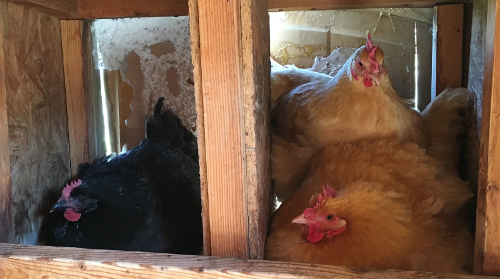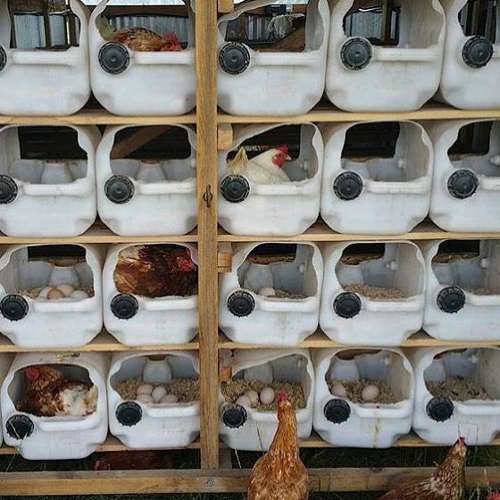How many chickens can share a nesting box?

You must have by law a maximum of 7 chickens per nesting box with a minimum of two nest boxes. The welfare of farmed animals act requires at least one nest for every seven hens. Hens love to share nests and sometimes they all seem to lay in the same one but the important thing is they must have a choice.
Why are nesting boxes important?
Nesting is a natural behaviour of chickens and to keep them happy it should be encouraged , just like scratching, roosting and dust bathing.
It keep the eggs in one easy to collect from safe place.
They need not be anything special, just clean dry and functional. Just about anything works if it is the right size.
The reason is that chickens tend to lay their eggs in the morning and it doesn't take much to create a queue of hens for a nest.
Below: Hen in the nest. Standard setup of wooden box filled with wood shavings.

There are plenty of experts that recommend 4 to 6 chickens per nesting box and from experience I would agree with this number. It does depend on your birds to some extent, Heritage chickens lay fewer eggs a week than hybrids. It is also better to have one more than you need than one less.
I have noticed hens prefer to lay and egg in a nest that already has an egg in it.
Chickens won't all be laying at the same time so the 3 box set up is fine for 12 birds.
They may even only choose to lay in one or two as well. The chickens individual personality, breed differences and environmental factors can all affect the ideal number of chickens per nesting box.
I had a count up of the number of hens and the ratio of chickens to nesting boxes in my setup
In one of my egg flock coops I have 30 hens and 8 boxes. Usually only about 4 of the boxes are used and they are the lowest ones near the floor. In the second big coop I have 73 girls and 10 boxes and most of them get used. I haven't included my breeding pens as these are normally a small group with one rooster and 2 boxes to three or four hens.
Chickens prefer very low lighting of less than 1 lux for nesting and so nest design and location should attempt to reflect these lower lighting needs.
Nesting boxes should have a slanting top to stop the hens roosting on them and fouling them with droppings. The perches and roosts should always be higher than the nest boxes. Standard hens can get away with 12 inch nesting boxes but larger birds like Orpingtons will need something a few inches bigger.
How many nesting boxes do I need for my chickens?
| No. of chickens. | No. of nesting boxes. |
| 6 | 2 |
| 10 | 2 |
| 15 | 3 |
| 20 | 4 |
| 30 | 5 |
| 50 | 8 |
| 100 | 18 |
This table should give you a rough idea of how many nest boxes you need for your flock size.
If in doubt go for one or two extra.
Does each chicken need a nesting box?
No, You do not need a nesting box for each chicken you have. Chickens can and do share nesting boxes, some quite amicably and some with plenty of squabbling.
Below: A queue for the nesting box.

If you have too few you risk nest wars, fighting and possible broken eggs. Too many hens fighting over the same nest might mean broken eggs with all the egg eating problems that go with that.
What is the law about nesting boxes for chickens?
There are laws which govern how many nest you need per hen and what the minimum requirements are. All nests should be :
- Nests must be a separate space for egg laying and the floor component of which may not include wire mesh which can come into contact with the birds. Floor substrates provided in the nest area should create an environment which encourages nesting (pre-laying) behaviour.
- Nests should be secluded, clearly separated from other areas and draught free, allowing laying hens to isolate themselves from those carrying out other activities.
- Individual nests should be designed to accommodate only one hen at a time. The nests should be easily accessible by all birds.
- The welfare of farmed animals act requires at least one nest for every seven hens.
While the law only applies to operations of 50 or more laying hens it makes good practice to follow it.
What do you put in a nesting box?
The best materials to go in a nesting box are:
Nesting pads - These are great to put in nesting boxes to help reduce lice/mites on chickens, easy to clean, soft for egg landings. Reduces the cost of hay the hens continuously kick out of the box! Can be cut to smaller size to fit smaller nesting boxes.
Fake grass - Easy to clean and can be got for free by getting a sample from a couple of stores.
Try some herbs like sage, rosemary or thyme - Add a handful of herbs every week or so to the nest boxes. The essential oils are supposed to help keep insects away but You should treat as well.
Wood shavings - A nice thick layer of wood shavings in the bottom of the nest. Cheap and easy.
Easychick bedding - Enough said, its designed to be bedding.
Sand - Yes, plain old builder sand. I have done it and it does work. After all chickens in the wild are ground nesters and would nest in sand or soil.
Straw or hay - Trouble is Red mite love straw!! Straw is nice and cosy but needs to be changed regularly and treated with DE (diatomaceous earth).
Below: A good setup with a sloped roof, nice fronts on the boxes and plenty of nesting material.

How high should a nesting box be?
The only rule is lower than the perches and roosts. Other than that it probably makes little difference. I have noticed that my hens prefer to use the lower nesting boxes when they have the choice.If I have the choice I would put the nesting boxes closer to the floor.
Below: A busy multi level setup of nest boxes. you can see the lower ones are better used.

By instinct chickens prefer to seek out the quieter and more secluded spots for egg laying.
The nest box itself should be at least 12 inches high, 12 inches deep and 12 inches wide.
Yes and you should give a sprinkle of diatomaceous earth in the nest on a regular basis. Pay special attention to the corners. DE is a great preventative treatment for all insects, not just mites and lice.
Getting your chickens used to using their nesting boxes:
Light. Chickens prefer low light for laying so use a slightly deeper box or tweak your setup so as the nests are darker.
Decoy eggs. Pottery or wooden eggs, one in each nest should encourage the hens to use the nesting boxes.
Put a golf ball in each nest. Cheap version of the above.
Coop them up for a few days. Keeping them shut in for a few hours in the morning while they lay eggs may get them into the habit of using the nesting boxes. Chickens mostly lay eggs in the morning so you can let them out as normal in the evening.
Time and patience. Don't rush, it will happen.
Borrow a hen that can teach them. So if you have a young flock it may be possible to borrow an older hen to show them how it's done. Being older she should be able to boss her way straight into the top of the pecking order.
One final word of caution - I thought I was doing my chickens a favour by buying some special nesting pads for them to lay their eggs on. NOT! They are creatures of habit it seems. Evidently they really liked their pine shavings.
They refused to lay an egg on the new nesting pads. Hilarious. So off to the store I go. Now they have their pine shavings back in the nest and they've already laid eggs in the boxes.
